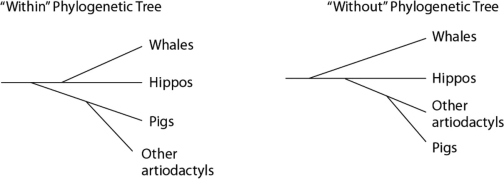Multiple Choice
Please use the following information to answer the question(s) below.
Traditionally, whales and hippopotamuses have been classified in different orders, the Cetacea and the Artiodactyla, respectively. Recent molecular evidence, however, indicates that the whales' closest living relatives are the hippos. This has caused some zoologists to lump the two orders together into a single clade, the Cetartiodactyla. There is no consensus on whether the Cetartiodactyla should be accorded order status or superorder status. This is because it remains unclear whether the whale lineage diverged from the lineage leading to the hippos before or after the other members of the order Artiodactyla (pigs, camels, etc.) diverged (see Figure 20.5) .  Figure 20.5
Figure 20.5
-It was once thought that cetaceans had evolved from an extinct group of mammals called the mesonychids. If, in the future, it is determined that some organisms currently classified as cetaceans did actually evolve from mesonychids, whereas other cetaceans evolved from artiodactyl stock, then what will be true of the order Cetacea?
A) It will be paraphyletic.
B) It will be polyphyletic.
C) It will need to be modified if classification is to reflect evolutionary history.
D) A and C
E) B and C
Correct Answer:

Verified
Correct Answer:
Verified
Q1: The common ancestors of birds and mammals
Q3: A potential source of confusion in constructing
Q15: Please use the following information to answer
Q28: Cladograms (a type of phylogenetic tree)constructed from
Q50: In addition to naming species, Linnaeus also
Q51: A) that these organisms are phenotypically more
Q54: A polytomy on a phylogenetic tree represents<br>A)
Q55: The relative lengths of the frog and
Q57: The importance of computers and of computer
Q58: The next question(s) refer to Table 20.1,